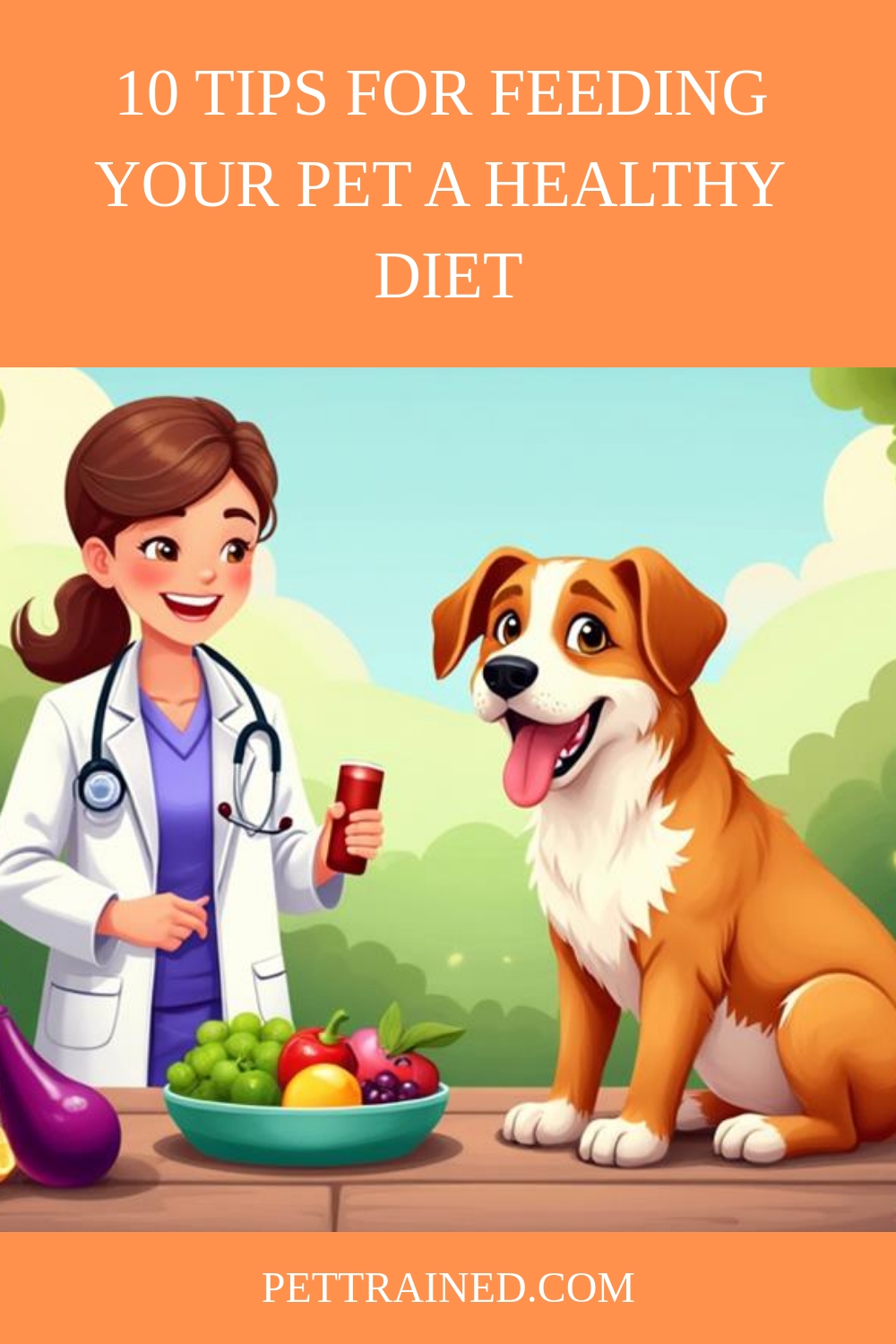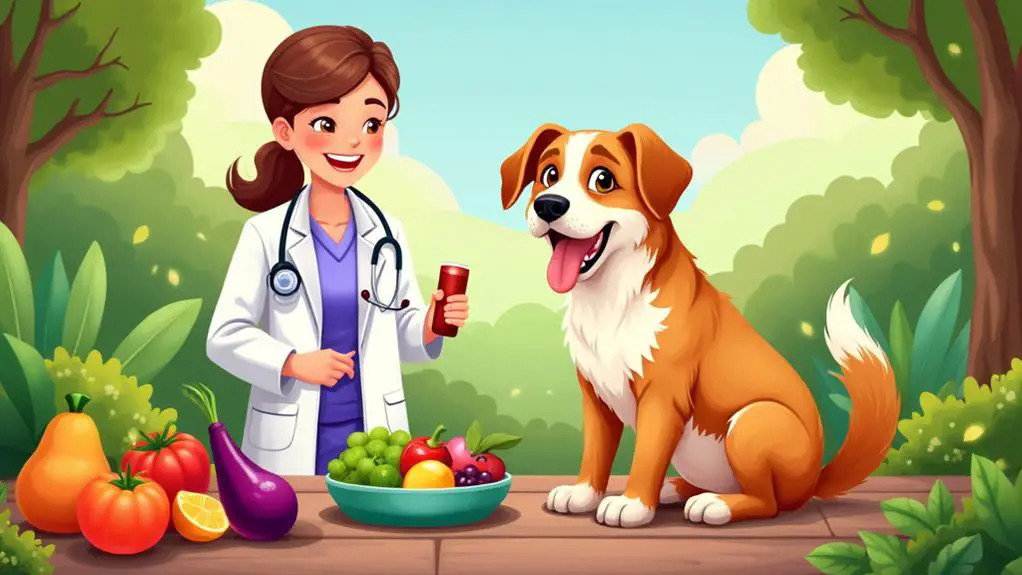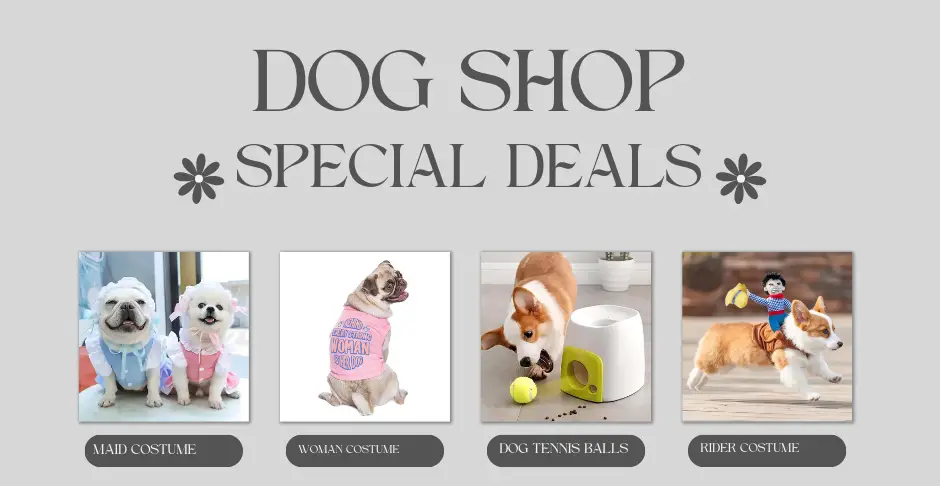As you navigate the world of pet nutrition, you’re likely to encounter a multitude of options and opinions on what constitutes a healthy diet for your furry friend. You’re probably wondering what sets a great pet food apart from a mediocre one, and how you can make informed decisions to support your pet’s overall well-being. By understanding the key principles of pet nutrition, you’ll be better equipped to make choices that have a lasting impact on your pet’s health. But what are the essential tips to get you started on this journey, and how can you guarantee you’re giving your pet the best possible start in life and feeding your pet a healthy diet?
Table of Contents
Key Takeaways
- Choose a high-quality pet food with named protein sources and whole grains for optimal nutrition.
- Read pet food labels carefully to ensure transparency and avoid vague terms or proprietary blends.
- Feed a balanced and complete diet that meets your pet’s nutritional needs, varying by life stage.
- Monitor your pet’s weight and adjust food portions accordingly to prevent obesity and related health issues.
- Provide fresh, clean water at all times and limit table scraps and treats to maintain a healthy diet.
Choose the Right Food Type

When choosing a healthy diet for your pet, it’s essential to select the right food type. You have several options, including dry food, wet food, and a raw diet. Some pets thrive on grain-free diets, while others may require special diets due to food allergies or sensitivities.
If you’re pondering a homemade meal plan, consult with a veterinarian to guarantee you’re providing a balanced diet. Be sure to understand the importance of dog food quality, as it can contribute to a longer, happier life for your pet. Awareness of ingredients is also important, as avoiding harmful components can reduce the risk of health issues like bloat, diabetes, and pancreatitis.
Portion control is important, regardless of the food type you choose. Overfeeding can lead to obesity and other health issues, so monitor your pet’s weight and adjust their feeding schedule accordingly. You may also need to take into account your pet’s flavor preferences, as some may be picky eaters.
In addition to a well-balanced diet, you may want to think about adding nutritional supplements to support your pet’s overall health. However, always consult with a veterinarian before adding any supplements to their diet.
This post contains affiliate links. However all the information provided on this site are my own honest opinions. See more in Disclaimer.
Read Pet Food Labels Carefully
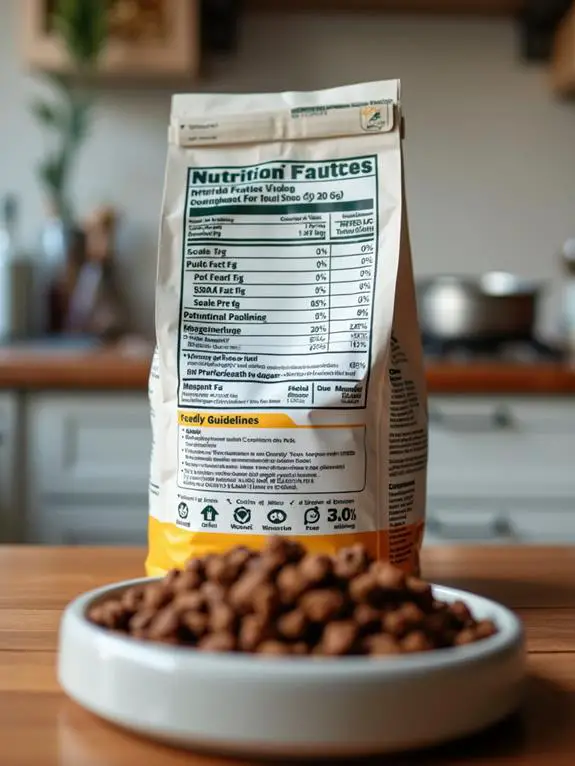
Now that you’ve chosen the right food type for your pet, it’s time to scrutinize the labels to confirm you’re getting the best quality.
Reading pet food labels carefully is vital to guarantee your pet is getting the nutrients they need. Look for labels that provide clear and concise information about the ingredients and their proportions. Check the protein sources, such as chicken, beef, or fish, and verify they’re named specifically. Avoid generic terms like “meat” or “by-products.”
Ingredient transparency is also essential. Opt for labels that list the ingredients in descending order of their proportions. This will give you an idea of what your pet is primarily consuming.
Be wary of labels that use vague terms or hide behind proprietary blends. You want to know exactly what you’re feeding your pet. By carefully reading the labels, you can make informed decisions about your pet’s diet and confirm they’re getting the nutrients they need to thrive.
Always check the label for any certifications or endorsements from reputable organizations, such as the Association of American Feed Control Officials (AAFCO).
Avoid Fillers and Byproducts
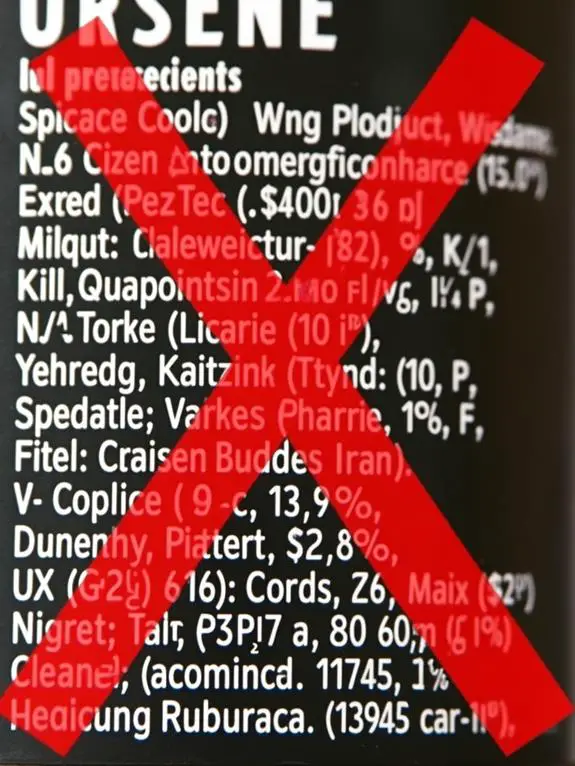
Scrutinizing pet food labels for fillers and byproducts is vital for guaranteeing your pet gets the nutrients they need. Fillers and byproducts are low-quality ingredients that provide little to no nutritional value, and can even harm your pet’s health.
When choosing a pet food, look for products that use quality ingredients and avoid those that contain fillers and byproducts. Opting for a pet food with named protein sources, such as chicken or salmon, and whole grains like brown rice or oats, can help guarantee your pet is getting the nutrients they need.
Proper nutrition is vital for strong, healthy dogs, and avoiding low-quality ingredients is a significant part of maintaining their well-being. Homemade diets can also be a great option, as they allow you to control the ingredient sourcing and guarantee that only quality ingredients are used. However, it’s important to consult with a veterinarian or canine nutritionist to guarantee the diet is well-balanced and complete.
Proper food storage and meal frequency can also impact your pet’s digestive health. Store pet food in a cool, dry place to prevent spoilage, and feed your pet at regular intervals to maintain a healthy digestive system.
Consider Your Pet’s Life Stage

Your pet’s nutritional needs change throughout their life, and selecting a pet food that meets these changing needs is vital for maintaining their overall health.
For instance, puppy nutrition is fundamental for growth and development, so it’s important to choose a puppy food that’s rich in protein and calories. Puppies require more protein and calories per pound of body weight than adult dogs, so a nutrient-dense puppy food is essential for ideal growth. Additionally, considering necessary nutrients like vitamins and minerals is important for their overall development.
As your pet matures, their nutritional needs change. Adult dogs require a balanced diet that maintains their weight and supports overall health. Senior dogs, on the other hand, require a senior diet that’s lower in calories and rich in joint supplements to support their aging joints. Senior diets may also be formulated to support kidney health and digestion.
It’s important to shift your pet to a senior diet at the right time to support their changing needs. By choosing a pet food that meets your pet’s life stage needs, you can help guarantee they stay healthy and thrive throughout their life.
Watch for Allergies and Sensitivities
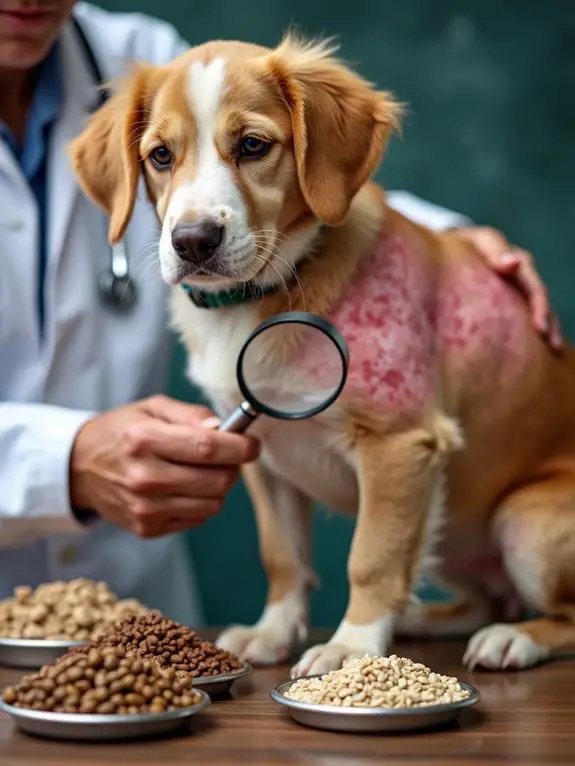
Watch for Allergies and Sensitivities
A common issue pet owners face is dealing with allergies and sensitivities in their pets. These can cause a range of symptoms, from mild discomfort to life-threatening reactions. As a responsible pet owner, it’s vital to identify and manage these issues to guarantee your pet’s overall health and well-being.
Food sensitivities can also lead to resource guarding behavior in some pets, as they may associate certain foods with discomfort or stress. Early identification of food triggers is significant for preventing negative associations.
When it comes to common allergens, some pets may react to certain ingredients in their food. Food sensitivities can also occur, leading to digestive issues or skin problems.
To address these concerns, consider the following:
- Identify common allergens: Beef, dairy, and soy are common culprits in pet food allergies.
- Monitor your pet’s behavior: Keep an eye out for signs of allergies or sensitivities, such as itching, scratching, or digestive issues.
- Consult with your veterinarian: If you suspect an allergy or sensitivity, consult with your vet to determine the best course of action.
- Consider a hypoallergenic diet: If your pet has a confirmed allergy or sensitivity, a hypoallergenic diet may be the solution.
Feed a Balanced and Complete Diet

A well-balanced and complete diet is the cornerstone of your pet’s overall health and well-being. As a pet owner, it’s important to provide your pet with the necessary nutrients for ideal health. A balanced diet typically includes a mix of protein, fat, carbohydrates, vitamins, and minerals.
You can achieve this by feeding your pet high-quality commercial pet food or preparing homemade meals under the guidance of a veterinarian or canine nutritionist. For example, incorporating fish-based foods can improve their skin and coat health and enhance their immune system.
If you’re unsure about the nutritional content of your pet’s food, consult with your veterinarian or consider adding nutritional supplements to guarantee your pet is receiving all the necessary nutrients.
When selecting a commercial pet food, choose one that’s formulated specifically for your pet’s life stage and lifestyle. Always check the ingredient list to confirm it contains whole foods, such as meat, fish, or poultry, as the first ingredient.
Avoid fillers and by-products that provide little nutritional value. By feeding your pet a balanced and complete diet, you’re investing in their long-term health and well-being, and reducing the risk of diet-related health issues.
Limit Table Scraps and Treats
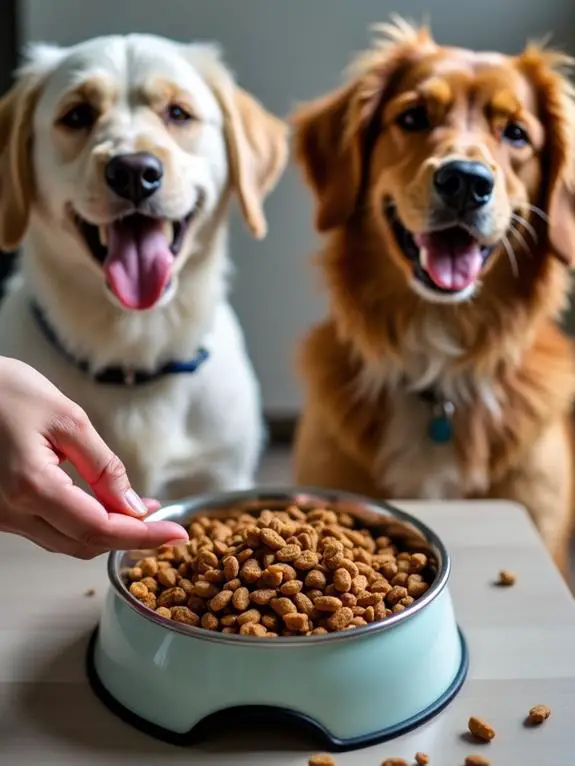
Limit Table Scraps and Treats
Limiting table scraps and treats is vital for maintaining your pet’s balanced diet. While it’s tempting to give in to those puppy dog eyes, feeding your pet table scraps and treats can lead to nutritional imbalances and weight gain.
It’s imperative to establish a consistent feeding routine and stick to healthy alternatives. Treats contribute considerably to calorie intake and obesity, so opting for healthy, low-calorie treats like green beans, carrots, and apples is beneficial. Gradual reduction of treats also aids in weight management.
Here are some tips to help you limit table scraps and treats:
- *Choose healthy alternatives*: Instead of giving your pet table scraps, consider healthy alternatives like carrot sticks or green beans. These options are low in calories and rich in nutrients.
- *Practice portion control*: When giving treats, make sure to keep them small and infrequent. A general rule of thumb is to limit treats to 10% of your pet’s daily calorie intake.
- *Avoid overfeeding*: Don’t overfeed your pet, as this can lead to weight gain and other health problems.
- *Set boundaries*: Establish clear rules for feeding your pet, and stick to them. Avoid giving in to begging, and consider using baby gates or pet crates to limit access to food.
Monitor Your Pet’s Weight
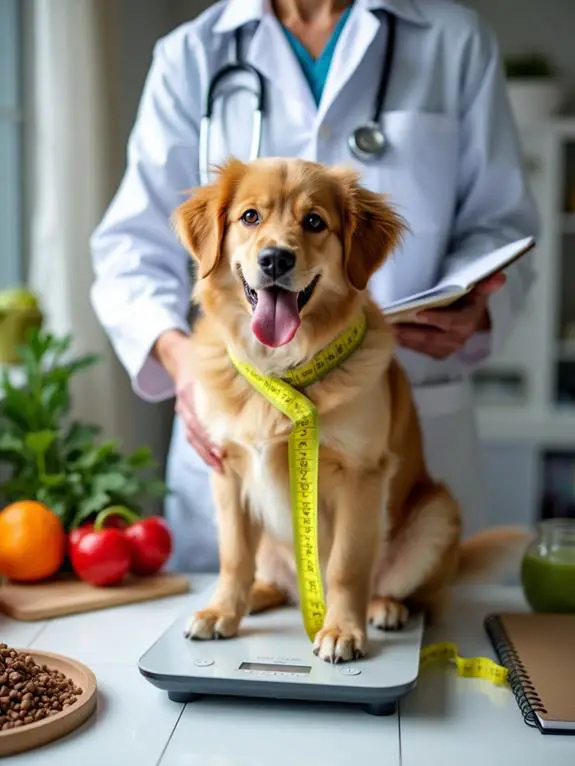
Maintaining a healthy weight is key to your pet’s overall well-being, and it’s closely tied to the food they eat. Monitoring your pet’s weight is vital to prevent obesity, which can lead to various health issues, such as diabetes, arthritis, and heart disease.
Additionally, weight management is critical for reducing joint strain, which supports their mobility and quality of life. To track your pet’s weight effectively, you should weigh them regularly, ideally every 2-3 months. This will help you identify any changes in their weight and make necessary adjustments to their diet.
Portion control is also essential in maintaining a healthy weight for your pet. Measure your pet’s food accurately, and avoid overfeeding or underfeeding. Use a measuring cup to guarantee you’re providing the right amount of food at each meal.
Additionally, consider using a weight management food that’s specifically formulated to help your pet achieve and maintain a healthy weight. By tracking your pet’s weight and practicing portion control, you can help prevent weight-related health issues and guarantee your pet lives a long, healthy life.
Regular weight tracking and portion control will also help you identify any potential health problems early on.
Provide Fresh Water Always
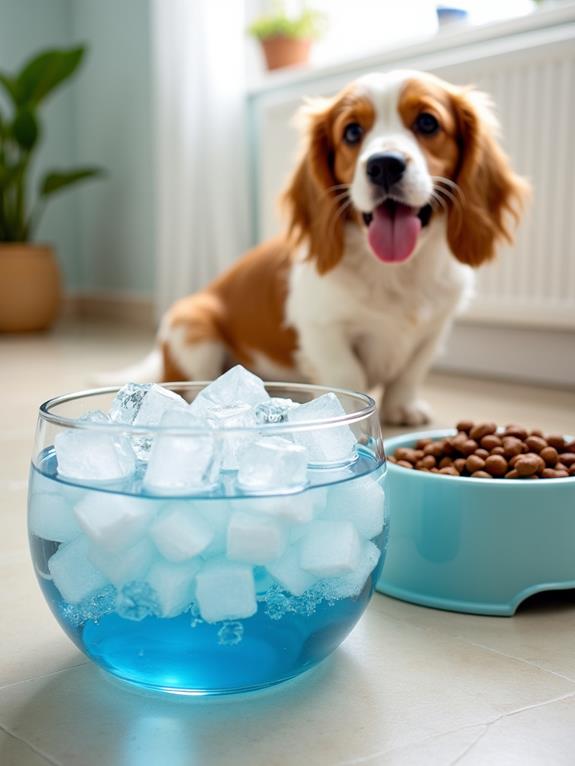
Provide Fresh Water Always
Every pet needs access to fresh, clean water at all times to stay healthy. You play a vital role in guaranteeing your pet’s hydration habits are met by providing a constant supply of fresh water. This is especially important for pets that are prone to dehydration, such as older pets or those with medical conditions.
Regularly checking your pet’s hydration status by observing their behavior and physical condition can also help in early detection of health issues.
To guarantee your pet always has access to fresh water, follow these tips:
- Change the water frequently to prevent bacterial growth and keep it fresh.
- Use a water filter or purification system to remove impurities and improve the taste.
- Place multiple water sources around the house to encourage your pet to drink more.
- Monitor the water temperature to guarantee it’s not too hot or cold for your pet to drink comfortably.
Consult With a Veterinarian
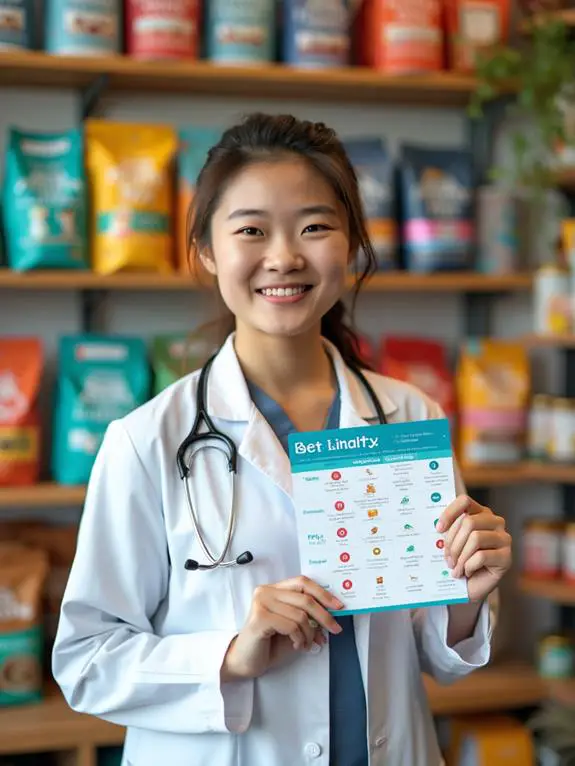
You’ve taken the first step in guaranteeing your pet’s health by providing a constant supply of fresh water.
Now, it’s time to focus on their diet. Consulting with a veterinarian is essential in determining the best food for your pet. A vet can help you create a personalized dietary plan tailored to your pet’s specific needs, taking into account their age, breed, and health conditions.
This is especially important if you have a large breed dog, as their feeding costs and dietary needs can differ greatly from smaller breeds. A veterinarian or a vet nutritionist can provide you with dietary recommendations that cater to your pet’s unique requirements.
They can help you choose the right food, whether it’s commercial or homemade, and guarantee it’s balanced and complete. They’ll also advise you on the correct portion sizes and feeding schedules to prevent overfeeding or underfeeding.
Frequent Questions and Answers
Carefully consider the consequences of consuming expired food. When it comes to pet food, you shouldn’t risk it – follow expiration date guidelines to guarantee pet food safety, as spoiled food can harm your pet.
You’ll want to rotate your pet’s food every 6-8 weeks to guarantee they’re getting a nutrient-balanced diet and to prevent food sensitivities from developing over time through consistent food rotation and a varied nutrient mix.
You think homemade diets are the way to go, but are they really better for your pet? While they offer benefits like customization, ensuring nutritional balance can be tricky, requiring careful planning and expertise.
You should consider feeding your pet raw or undercooked meat, but it’s crucial to weigh raw meat benefits against raw meat risks, as bacterial contamination can occur, and parasite transmission is also possible from raw consumption.
You consider switching to grain-free, but is it the best choice? On one hand, grain-free benefits your pet’s digestion and energy levels. On the other, potential risks include nutrient deficiencies and higher costs, weigh your options carefully.
